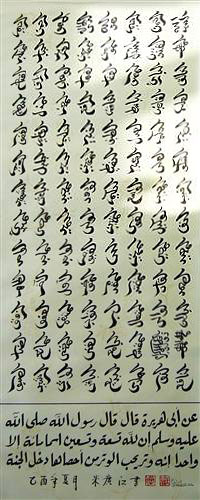As the sun is going down the horizon, we set for Edirnekapi, the west end part of the old city of Istanbul. I learned that the area is called Edirnekapi because apparently this is where a gate back then stood where it leads to Edirne, one of the Ottoman city in European Turkey. Soon enough, as we approached the district, there is a large tall ancient looking wall that stood during the Byzantine empire in the distance. This is where it seems where the Ottomans broke into Constantinople during the 1453 siege. This area seems to me to be more traditional than the rest of Istanbul ; the locale looked more middle eastern than the rest of Istanbul, where uncles and aunties wear traditional Islamic attire. In fact, I think there are a lot more older people in this area. When we arrived it was quite busy with traffic, perhaps it was during the rush hour, where everyone was going home after a day of work.
As we strolled around the wall, we found bits of interesting designs, some apparently Byzantine, with Christian crosses and acanthus leaves motifs. There were also a few calligraphic panels, seemingly from the Ottoman era, particularly near the gate. We climbed the quite tall wall of old Constantinople before sunset to take a panoramic view over Istanbul and witness the magnificent amber colour of the sunset. There was a deep dark well nearby – perhaps a remnant of a turret or a tower from the old wall. Other than that, the wall does not offer anything else but the history it held, and the panoramic view of the city it offers
Now, I was quite sure before going to Edirnekapi, we stopped by a mosque – you can see the photos below where I had noted it. The trouble is, I could not remember the name of the mosque and I could not identify it! There are a few unique features this mosque has, where the decoration were mostly painted on. But the name and exact location of this mosque escapes my mind. Perhaps my readers can enlighten me on this? If you have any information on this mosque with these few pictures I had provided I would like to know more! Please leave your comments below.
As the call of prayer reverberates from the minaret of the Mihrimah Sultan Mosque, we started to go down the wall and proceeded to the mosque for Maghrib prayers. The mosque is quite unique. Like Yavuz Sultan Selim Mosque, the plan of the mosque is square, sitting on top of a terrace. In front of the mosque is a courtyard with a sadirvan in the center, a common feature of Ottoman mosques. A single minaret stood on one corner of the cube that is the prayer hall. Unlike Yavuz Sultan Selim mosque though, the mosque is taller and the dome is taller as well. The mosque is commissioned by Sultan Suleiman the Great with his daughter Mihrimah Sultan’s namesake, designed by the famous Ottoman architect Mimar Sinan. There is also another mosque with the same name and the Asian side of Istanbul. When I read up about these mosques and why there were named similarly, there was an interesting story about the Princess, Mihrimah Sultan and the Imperial Architect, Mimar Sinan. Apparently, Sinan was in love with the Princess, who was then the wife of the governor of Diyarbakir. His love could not be, and he expressed this hopeless love with these mosques. The singular minaret for the Edirnekapi mosque represents the loneliness of the great architect for his love. Another extremely interesting thing is that the Edirnekapi mosque was built where the sun goes down on 21st of March every year (which is a week before I had visited). This particular date is in fact the birthday of the Princess. It is said that on this day, one can see the sun set past the minaret of the Edirnekapi mosque, and the Moon rise past the Uskudar (Asian side of Istanbul) Mihrimah Sultan mosque. To add to the beauty of this story, the name Mihrimah actually means Sun and Moon in Persian.
*Le Sigh.*
The mosque itself was tall, large and airy, thanks to the presence of large windows on most of the walls. Typical of Ottoman architecture, the building utilizes a lot of marble. Decoration were done in a harmonious colour combination of blue and red, and this is presented nicely with the calligraphic medallions under the main dome as well as the arches supporting the dome. The calligraphy works themselves are quite beautiful and unique. Those on the arches supporting the dome is particularly interesting, as it combines calligraphy and geometric design. I think I will recreate one in the future. The main calligraphy medallion under the dome is a work on the Nur Chapter ayat 35 (24:35) of the Quran, another favourite subject or Ottoman calligraphists. The ayat rang even truer here, where light flooded the space in abundance. Even in the late afternoon soon-to-be-sunset time, the light just permeates every inch of the building. A large iron chandelier hands in the middle of the mosque, hanging from the massive dome.
As the night falls after the prayer service , we proceeded to another mosque, the last one for the long day of Islamic art and architecture tour.

The panoramic view of the city, seen from the old city wall.

A dome decoration in a mosque

Painting decoration that looks like the pattern in an Iznik tiles

A hadith (Prophetic Saying) calligraphic work

The lone minaret of the Mihrimah Sultan Mosque in Edirnekapi

The interior of the mosque with the tall airy space

The central dome of the mosque

Another view of the dome, with the four calligraphic-geometric design medallions

A close up of the marble Mihrab

The central design in the carpet of the mosque, of a radial design featuring a seven pointed star, seven five pointed stars and fourteen six pointed stars. The design mirrors the on under the dome, but of course, without the calligraphy.
















